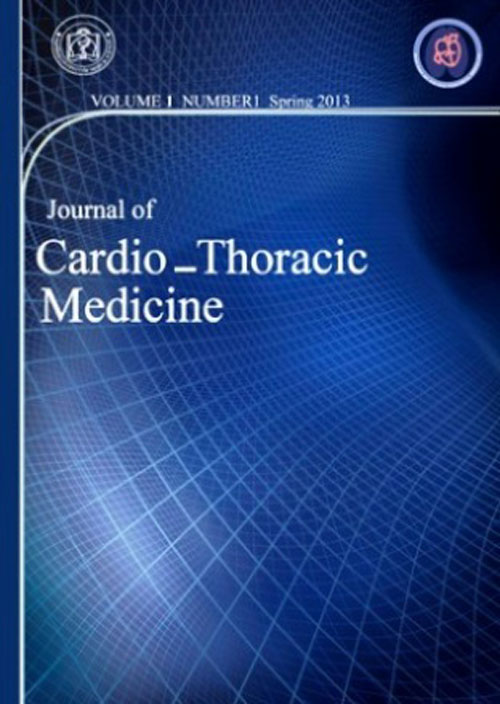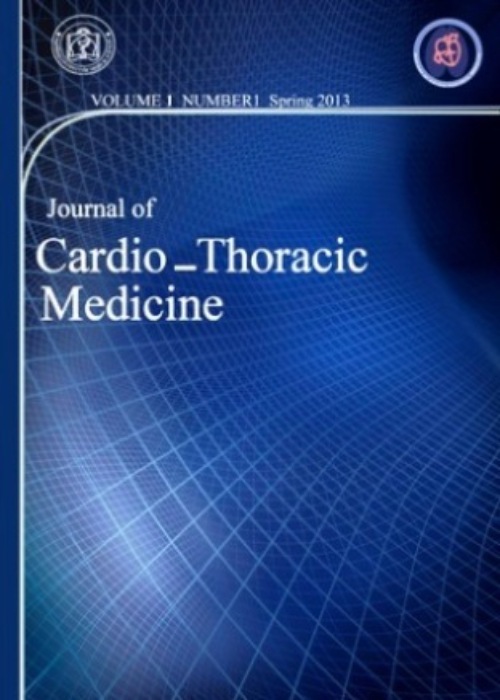فهرست مطالب

Journal of Cardio -Thoracic Medicine
Volume:9 Issue: 3, Summer 2021
- تاریخ انتشار: 1400/07/10
- تعداد عناوین: 7
-
-
Pages 833-838Introduction
Obesity is a common risk factor associated with cardiovascular disease (CVD) risk. Curcumin has been reported to exert beneficial effects on lipid metabolism, including HDL functionality. We have examined the effects of curcumin on HDL cholesterol uptake capacity in subjects with obesity.
Materials and Methods30 obese individuals received curcumin and placebo 1 g per day for a period of 30 days. The subjects were crossed over to the alternative regimen after a 2-week washout period. A modified cholesterol uptake capacity (CUC) assay was used to determine serum HDL functionality.
ResultsThe study groups had similar base line characteristics. We did not find significant effects (p>0.05) of curcumin on serum HDL CUC levels.
ConclusionCurcumin administration at a dose of 1 g per day for 30 days did not affect HDL CUC in subjects with obesity.
Keywords: Curcuma longa, Curcumin, Cholesterol Uptake Capacity, metabolic syndrome -
Pages 839-844Introduction
Chronic Total Coronary Occlusion has a high risk of mortality associated with Acute Coronary Syndrome with significantly ventricular disfunction reflected in functional class patient by intolerance to perform physical effort. The Percutaneous Coronary Intervention is the gold standard approach, but in many patients this procedure is not successful. Cardiac Rehabilitation and Secondary Prevention Programs has showed improve the patient's ability to perform physical effort by its positive effect on endothelial function and promote angiogenesis, increasing the ischemic threshold. We evaluate the Cardiac Rehabilitation and Secondary Prevention program effect on myocardial performance and ischemic profile in successful and unsuccessful Chronic Total Occlusion Percutaneous Coronary Intervention patients.
Materials and MethodsA non-randomized clinical trial was conducted in patients with CTCO underwent to Percutaneous Coronary Intervention (PCI). Patients were divided into two groups: 1) With successful PCI and 2) With unsuccessful PCI. All patients underwent a Sestamibi-Dipyridamole cardiac scan and stress test before and after of CRH&SP. The cardiac rehabilitation program considered 4-6 weeks of 5 weekly 30-minute training sessions with aerobic at 70% of Heart Resistance Reserve (HRR), with interspersed 3 weekly strength training sessions, as well as nutritional and Psychiatric group interventions.
ResultsWe evaluated 25 patients with successful PCI (n = 13) and unsuccessful PCI (n = 12). For both groups, the CRH&SP showed significant improvement (p <0.05) in myocardial performance parameters, ischemic profile, and physical effort tolerance, with a Cohen's Delta ≥ 80% in Nuclear Medicine Risk, NYHA functional class, METs reached, oxygen consumption, Myocardial Efficacy Index and Duke Score.
ConclusionsThe CRH&SP has a high positive effect on ventricular function improvement, myocardial performance, and ischemic profile in patients with Chronic Total Coronary Occlusion.
Keywords: Chronic Total Occlusion, Secondary Prevention, Percutaneous Coronary, Interventionism -
Pages 845-853IntroductionIntubation is the common medical procedure which involves the insertion of a plastic tube which is a flexible tube in the throat of the patient. Reintubation is described as the failed extubation or patient get intubation after extubation who had been initially tracheal intubated.The purpose of the study was to determine the Spiro metric parameters among post Extubated patients and the application of Non-Invasive Ventilation for - prevention of reintubation.Materials and MethodQuantitative research approach with purposive sampling technique was adopted to include 38 participants. Data were collected by providing spirometry immediately after extubation. The data were analyzed using descriptive statistics.ResultsThe result shows that 36.84% of participants required non-invasive ventilation after extubation who were having FEV1 between 0.38-1.48, FVC between 0.44-1.75, PEFR between50-70. Hemodynamic variable like saturation (0.01), PCO2 (0.00), PO2 (0.03), and HCO3 (0.00) were highly significant at the level of p < 0.05. Proving that patients whose saturation level& ABG profile like PCO2, PO2, and HCO3 are not maintained required NIV after extubation.ConclusionStudy concludes that in Extubated patient’s prophylactic non-invasive ventilation prevents extubation failure assessing the Spiro metric parameters in patients who can maintain saturation with less oxygen support, is also important in predicting good outcome of non-invasive ventilation after extubation.Keywords: Clinical variables, Post - Extubated Patients, Non-invasive Ventilation, Spontaneous Breathing Trial, Spirometric parameters
-
Pages 854-857
Cardiac injury is a common unexpected injury with high rate of mortality in multi-trauma patients. Blunt thoracic trauma leading to heart injury presented with variable presentations from myocardial contusion to rupture. Cardiac injury is about 15% - 25% of blunt chest trauma. Cardiac contusion is the most common type of injury with variable manifestations associated with electrocardiogram (ECG) changes or cardiac enzyme abnormality. Traumatic rupture of intra-cardiac structures after blunt Thoracic trauma is an uncommon. Cardiac valves rupture is uncommon, and the most frequent being aortic valve, and then followed by mitral and tricuspid. Nowadays, the incidence of these types of injury is increasing due to high increase of road traffic accidents (RTA). Following blunt thoracic trauma, rupture of papillary muscle or its chordae tendineae is a very rare causing acute mitral regurgitation (MR) with sequence of congestive heart failure (HF) and pulmonary edema.
Keywords: Acute Mitral Regurgitation, Blunt chest trauma, Papillary muscle rupture -
Pages 858-862
Pulmonary pneumatoceles (PCs) are thin-walled, air-filled cysts that develop within pulmonary parenchyma. PCs are usually seen in the lung after infection, trauma. In case of infection, as a complication of acute pneumonia, caused by Staphylococcus aureus, and are more frequently in infants and children. Adult tuberculous pulmonary pneumatoceles are seldom reported. PCs are usually asymptomatic. Large PCs may compress adjacent lung with mediastinal shift causing respiratory or cardiovascular symptoms. Surgical intervention is only indicated when PCs cause cardiopulmonary compromise or rupture into the pleural space or unresolved infection.
Keywords: pulmonary pneumatocele, pulmonary tuberculosis, Fungal Ball, Cardiopulmonary Compromise -
Pages 863-866
Traumatic carotid artery jugular vein fistula is a rare entity that is not usually detected during the acute injury phase. We presented 1 cases of traumatic carotid–jugular fistula. A 52 years old man that was referred to us because of an expanding neck hematoma. There was a 1×1 cm ulcer with a clot in zone II right neck and a thrill was palpated. We clamped the proximal and distal site of injury (Arteriovenous fistula), then divided the fistula and primarily repaired the artery (transversely) and the vein with 7-0 prolene suture. We placed two hemovac drains and then repaired the subcutaneous and skin and covered the site with gauze and then the patient was transferred to ICU. He was extubated the next day and physical exam was completely normal without any neurologic deficit. Carotid–jugular fistula should always be treated early to avoid the complications associated with the injury.
Keywords: carotid, fistula, Traumatic, jugular -
Pages 867-868
In current observational study, we have reported a patient with Iraqi nationality suffering from chondroblastic osteosarcoma of the clavicle (Figure 1). He aged 17 years old having height 1.75 m and weight 60 kg without any family history of malignancy. The signs have been started 1 year ago as a painful swelling. MRI showed a cortical expansion and bone destruction (Figure 2). Diagnosis was made based on fine needle aspiration (FNA) and biopsy. The patient underwent a chemotherapy course but did not respond to the treatment. After chemotherapy, he did not take any medicine and referred to the physician’s office with swelling in right clavicule in 30th January, 2021. 3 months after the end of chemotherapy, the claviculectomy surgery was performed without reconstruction. He underwent the sub-total clavicular resection surgery at Razavi Hospital, Mashhad, Iran. Tumor swelling was 3 x 4 cm and the length of the excised clavicle was about 7 cm (Figure 3). Two months after the surgery, he was followed up and stated no issues. Figure 4 has shown light micrograph with a numerous fusiform osteoblastic cells.
Keywords: Chondroblastic, Osteosarcomas, Clavicle


